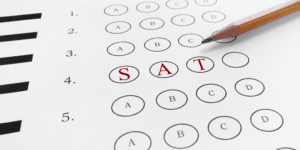For many students burrowing down the GMAT preparation rabbit hole, the most daunting component is that part of the exam that has been a staple of our standardized testing career—reading comprehension. Though we’ve been taught many differing strategies to tackle reading sections over the years, you will find as you embark on your GMAT preparation that GMAT Reading Comprehension is quite a different beast. Here are some GMAT Reading tips to get you started on the right path.
GMAT Reading Comprehension—A Sizable Chunk of Your Verbal Score
The GMAT Verbal Section contains three question-types: Critical Reasoning, Sentence Corrections, and Reading Comprehension, amounting to 36 questions for which you will have 65 minutes to complete. On any given Verbal section, you will most likely see 3 or 4 passages, each containing 3 or 4 questions. Thus, Reading Comprehension constitutes about a third of your Verbal score.
The reading passages are designated as short or long, and usually you will be faced with 2 or 3 short passages (200-250 words) and one longer passage (300+ words). Thankfully, these lengths are a bit friendlier than the 700-900-word passages on other standardized tests, but brevity by no means makes them easier.
GMAT Reading Comprehension—How It Works in a Question-Adaptive Exam
As the GMAT is a question-adaptive exam, the reading passages are presented on the left half of your computer screen (and you are able to scroll up and down within the passage), and each question will appear in succession on the right. You cannot move on to the next question until you have answered the one that appears in front of you. Thus, you cannot skip over a reading question and return later, nor can you return to a previous question to change your answer. Based on this unique structure, you will need to alter your usual reading comprehension strategy derived from previous standardized tests. Here’s what we would recommend:
GMAT Reading Comprehension Tip 1: Read the Whole Passage
The content of the reading passages on the GMAT tends to be very technical, dense, and detail oriented. You simply cannot afford to “skim” the passage or cherry-pick certain sentences. Ya gotta read it all! And you have to practice this reading process as much as you can. Here is how you might approach the passage.
GMAT Reading Comprehension Tip 2: Read Selectively and Proactively
It might seem weird to think that you have to “learn how to read” the GMAT passage, but in many ways you have to adjust your “real-world” approach to reading. We are so conditioned to reading for content that we lose sight of how to read for structure and style.
On GMAT passages, you must read critically, focusing not only on what is being said, but also, and even more importantly, on how it’s being said. You must analyze the passage, focusing on the author’s purpose: why did he/she sit down to write this piece? On this same higher level of awareness, you should analyze the author’s style and tone. Overall, is this a description, an explanation, or an argument?
Consequently, one of the biggest GMAT Reading tips is that you should try to identify and interpret various contextual clues:
- Shift words (yet, but, however, etc.) – Often key points are made via contrast
- Continuity words (consequently, moreover, indeed, etc.)
- Paragraph function: make it a point to trace the relationship of each paragraph and how it structurally fits into the main idea
Reading Comprehension Tip 3: Consider Bullet-Pointing
Most students immediately dismiss the idea of taking any kind of notes on GMAT passages. And it’s true, your time is limited per passage, and you have either a whiteboard or an acetate booklet to deal with. But many students do find it helpful to jot down some bullet points on a limited basis. It’s not that difficult to pick out two or three points per passage, and it can definitely help organize your thoughts.
Reading Comprehension Tip 4: Pace Yourself
As discussed above, you will see 3 or 4 passages, each with 3 or 4 questions. In addition to general pacing guidelines for the GMAT, consider the following:
- Reading Comprehension – about 6 – 8 minutes per passage
- 2 – 3 minutes – Critically Reading the Passage
- 1.5 minutes to answer each question
With continued practice, you will naturally pick up speed and accuracy.
Reading Comprehension Tip 5: Call Us for Your GMAT Prep
In our 35+ years of tutoring, we’ve found that a strategy-first approach to standardized testing works best, and the GMAT is no exception. Your tutor will help you figure out which topics and question-types need the most work, then teach you ways to overcome those questions. This is a very learnable test, and all it takes is some time and determination. If you haven’t started working with us yet, give us a call and get started today!




